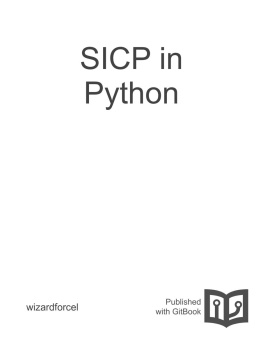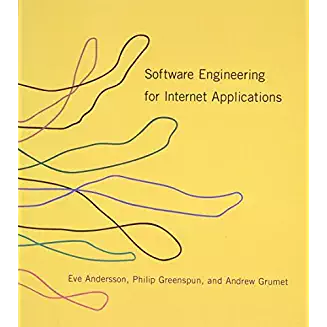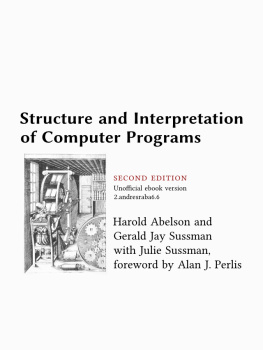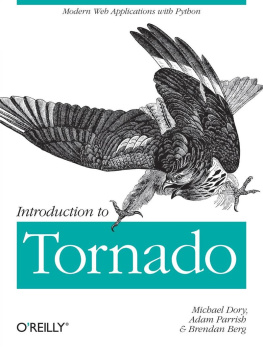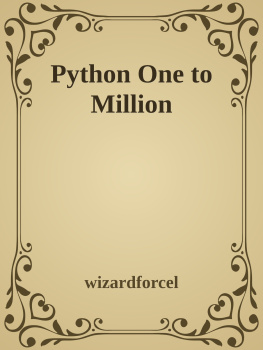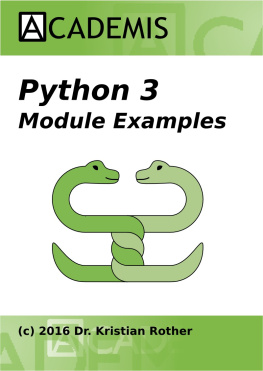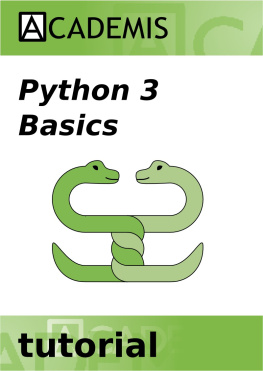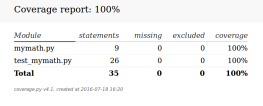it-ebooks - SICP in Python
Here you can read online it-ebooks - SICP in Python full text of the book (entire story) in english for free. Download pdf and epub, get meaning, cover and reviews about this ebook. year: 2016, publisher: iBooker it-ebooks, genre: Computer. Description of the work, (preface) as well as reviews are available. Best literature library LitArk.com created for fans of good reading and offers a wide selection of genres:
Romance novel
Science fiction
Adventure
Detective
Science
History
Home and family
Prose
Art
Politics
Computer
Non-fiction
Religion
Business
Children
Humor
Choose a favorite category and find really read worthwhile books. Enjoy immersion in the world of imagination, feel the emotions of the characters or learn something new for yourself, make an fascinating discovery.
SICP in Python: summary, description and annotation
We offer to read an annotation, description, summary or preface (depends on what the author of the book "SICP in Python" wrote himself). If you haven't found the necessary information about the book — write in the comments, we will try to find it.
SICP in Python — read online for free the complete book (whole text) full work
Below is the text of the book, divided by pages. System saving the place of the last page read, allows you to conveniently read the book "SICP in Python" online for free, without having to search again every time where you left off. Put a bookmark, and you can go to the page where you finished reading at any time.
Font size:
Interval:
Bookmark:
Contents
Computer science is a tremendously broad academic discipline. The areas of globally distributed systems, artificial intelligence, robotics, graphics, security, scientific computing, computer architecture, and dozens of emerging sub-fields each expand with new techniques and discoveries every year. The rapid progress of computer science has left few aspects of human life unaffected. Commerce, communication, science, art, leisure, and politics have all been reinvented as computational domains.
The tremendous productivity of computer science is only possible because it is built upon an elegant and powerful set of fundamental ideas. All computing begins with representing information, specifying logic to process it, and designing abstractions that manage the complexity of that logic. Mastering these fundamentals will require us to understand precisely how computers interpret computer programs and carry out computational processes.
These fundamental ideas have long been taught at Berkeley using the classic textbook Structure and Interpretation of Computer Programs (SICP) by Harold Abelson and Gerald Jay Sussman with Julie Sussman. These lecture notes borrow heavily from that textbook, which the original authors have kindly licensed for adaptation and reuse.
The embarkment of our intellectual journey requires no revision, nor should we expect that it ever will.
> We are about to study the idea of a computational process. Computational processes are abstract beings that inhabit computers. As they evolve, processes manipulate other abstract things called data. The evolution of a process is directed by a pattern of rules called a program. People create programs to direct processes. In effect, we conjure the spirits of the computer with our spells.> > The programs we use to conjure processes are like a sorcerer's spells. They are carefully composed from symbolic expressions in arcane and esoteric programming languages that prescribe the tasks we want our processes to perform.> > A computational process, in a correctly working computer, executes programs precisely and accurately. Thus, like the sorcerer's apprentice, novice programmers must learn to understand and to anticipate the consequences of their conjuring.> > Abelson and Sussman, SICP (1993)
> A language isnt something you learn so much as something you join.> > Arika Okrent
In order to define computational processes, we need a programming language; preferably one many humans and a great variety of computers can all understand. In this course, we will learn the Python language.
Python is a widely used programming language that has recruited enthusiasts from many professions: web programmers, game engineers, scientists, academics, and even designers of new programming languages. When you learn Python, you join a million-person-strong community of developers. Developer communities are tremendously important institutions: members help each other solve problems, share their code and experiences, and collectively develop software and tools. Dedicated members often achieve celebrity and widespread esteem for their contributions. Perhaps someday you will be named among these elite Pythonistas.
The Python language itself is the product of a large volunteer community that prides itself on the diversity of its contributors. The language was conceived and first implemented by Guido van Rossum in the late 1980's. The first chapter of his Python 3 Tutorial explains why Python is so popular, among the many languages available today.
Python excels as an instructional language because, throughout its history, Python's developers have emphasized the human interpretability of Python code, reinforced by the Zen of Python guiding principles of beauty, simplicity, and readability. Python is particularly appropriate for this course because its broad set of features support a variety of different programming styles, which we will explore. While there is no single way to program in Python, there are a set of conventions shared across the developer community that facilitate the process of reading, understanding, and extending existing programs. Hence, Python's combination of great flexibility and accessibility allows students to explore many programming paradigms, and then apply their newly acquired knowledge to thousands of ongoing projects.
These notes maintain the spirit of SICP by introducing the features of Python in lock step with techniques for abstraction design and a rigorous model of computation. In addition, these notes provide a practical introduction to Python programming, including some advanced language features and illustrative examples. Learning Python will come naturally as you progress through the course.
However, Python is a rich language with many features and uses, and we consciously introduce them slowly as we layer on fundamental computer science concepts. For experienced students who want to inhale all of the details of the language quickly, we recommend reading Mark Pilgrim's book Dive Into Python 3, which is freely available online. The topics in that book differ substantially from the topics of this course, but the book contains very valuable practical information on using the Python language. Be forewarned: unlike these notes, Dive Into Python 3 assumes substantial programming experience.
The best way to get started programming in Python is to interact with the interpreter directly. This section describes how to install Python 3, initiate an interactive session with the interpreter, and start programming.
As with all great software, Python has many versions. This course will use the most recent stable version of Python 3 (currently Python 3.2). Many computers have older versions of Python installed already, but those will not suffice for this course. You should be able to use any computer for this course, but expect to install Python 3. Don't worry, Python is free.
Dive Into Python 3 has detailed installation instructions for all major platforms. These instructions mention Python 3.1 several times, but you're better off with Python 3.2 (although the differences are insignificant for this course). All instructional machines in the EECS department have Python 3.2 already installed.
In an interactive Python session, you type some Python code after the prompt, >>>. The Python interpreter reads and evaluates what you type, carrying out your various commands.
There are several ways to start an interactive session, and they differ in their properties. Try them all to find out what you prefer. They all use exactly the same interpreter behind the scenes.
The simplest and most common way is to run the Python 3 application. Type
python3at a terminal prompt (Mac/Unix/Linux) or open the Python 3 application in Windows.A more user-friendly application for those learning the language is called Idle 3 (
idle3). Idle colorizes your code (called syntax highlighting), pops up usage hints, and marks the source of some errors. Idle is always bundled with Python, so you have already installed it.- The Emacs editor can run an interactive session inside one of its buffers. While slightly more challenging to learn, Emacs is a powerful and versatile editor for any programming language. Read the 61A Emacs Tutorial to get started. Many programmers who invest the time to learn Emacs never switch editors again.
Font size:
Interval:
Bookmark:
Similar books «SICP in Python»
Look at similar books to SICP in Python. We have selected literature similar in name and meaning in the hope of providing readers with more options to find new, interesting, not yet read works.
Discussion, reviews of the book SICP in Python and just readers' own opinions. Leave your comments, write what you think about the work, its meaning or the main characters. Specify what exactly you liked and what you didn't like, and why you think so.

